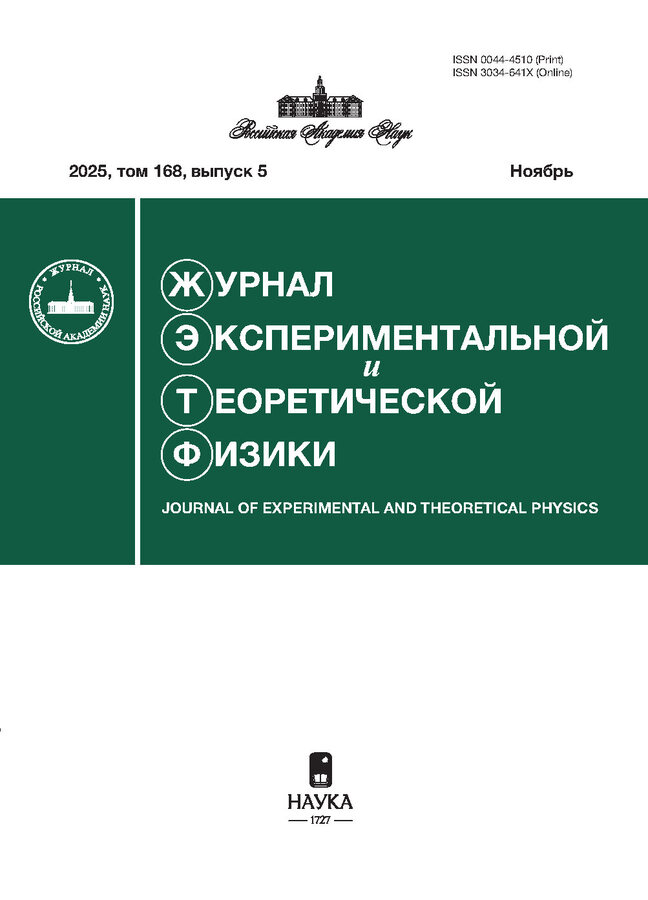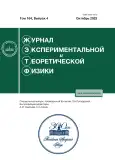Magnetooptical Kerr Spectroscopy of Nanocomposites
- Authors: Gan'shina E.A1, Garshin V.V1, Perova N.N1, Pripechenkov I.M1, Yurasov A.N2, Yashin M.M2, Ryl'kov V.V3,4, Granovskiy A.B1,4
-
Affiliations:
- Physics Faculty, Moscow State University
- Russian Technological University MIREA
- State Research Center “Kurchatov Institute”
- Institute of Theoretical and Applied Electrodynamics, Russian Academy of Sciences
- Issue: Vol 164, No 4 (2023)
- Pages: 662-672
- Section: Articles
- URL: https://journals.rcsi.science/0044-4510/article/view/247347
- DOI: https://doi.org/10.31857/S0044451023100188
- EDN: https://elibrary.ru/XLZRSE
- ID: 247347
Cite item
Full Text
Abstract
Magnetooptical spectroscopy is an effective method for studying the magnetic microstructure of homogeneous and heterogeneous magnets. This review is devoted to analysis of numerous factors affecting the intensity and spectral dependence of a magnetooptical signal of the equatorial Kerr effect in nanocomposites “ferromagnetic metal–dielectric” in the visible and near infrared spectral regions. Examples of the influence of the metal concentration, nanoparticle size and shape, the substrate, the material of the dielectric, the amorphization of grains, the deposition method, and other factors on the magnetooptical spectrum are considered. The differences in the magnetooptical spectra for the superparamagnetic, superferromagnetic, and ferromagnetic states are demonstrated. It is noted that in the presence of fractions with different field dependences of the magnetization in a nanocomposite, the magnetooptical signal is not proportional to the total magnetization. Examples of enhancement and sign inversion of the magnetooptical signal in nanocomposites are considered. The possibility of the description of magnetooptical spectra using the methods of the effective medium (the Bruggeman method and the Maxwell–Garnett symmetrized approximation) is discussed.
About the authors
E. A Gan'shina
Physics Faculty, Moscow State University
Email: eagan@mail.ru
119991, Moscow, Russia
V. V Garshin
Physics Faculty, Moscow State University
Email: eagan@mail.ru
119991, Moscow, Russia
N. N Perova
Physics Faculty, Moscow State University
Email: eagan@mail.ru
119991, Moscow, Russia
I. M Pripechenkov
Physics Faculty, Moscow State University
Email: eagan@mail.ru
119991, Moscow, Russia
A. N Yurasov
Russian Technological University MIREA
Email: eagan@mail.ru
119454, Moscow, Russia
M. M Yashin
Russian Technological University MIREA
Email: eagan@mail.ru
119454, Moscow, Russia
V. V Ryl'kov
State Research Center “Kurchatov Institute”; Institute of Theoretical and Applied Electrodynamics, Russian Academy of Sciences
Email: eagan@mail.ru
123182, Moscow, Russia; 125412, Moscow, Russia
A. B Granovskiy
Physics Faculty, Moscow State University; Institute of Theoretical and Applied Electrodynamics, Russian Academy of Sciences
Author for correspondence.
Email: granov@magn.ru
119991, Moscow, Russia; 125412, Moscow, Russia
References
- A. K. Zvezdin and V. A. Kotov, Modern Magnetooptics and Magnetooptical Materials, CRS Press (2020).
- Г. С. Кринчик, Физика магнитных явлений, МГУ (1985).
- V. Antonov, B. Harmon, and A. Yaresko, Electronic Structure and Magneto-Optical Properties of Solids, Kluver Acad. Publ., Dordrecht (2004).
- В. В. Рыльков, А. В. Емельянов, С. Н. Николаев и др., ЖЭТФ 158, 164 (2020).
- S. H. Ohnuma, H. Fujimori, S. Mitani et al., J. Appl. Phys. 79, 5130 (1996).
- M. N. Martyshov, A. V. Emelyanov, V. A. Demin et al., Phys. Rev. Appl. 14, 034016 (2020).
- C. N. Gao, Y. X. Yang, Y. Q. Xiong et al., J. Phys. D 47, 045003 (2014).
- S. Bedanta and W. Kleemann, J. Phys. D 42, 013001 (2009).
- G. A. Niklasson and C. G. Granqvist, J. Appl. Phys. 55, 3382 (1984).
- A. Granovsky, M. Kuzmichev, and J. P. Clerc, J. Phys. Soc. Jpn 23, 382 (1999).
- Е. А. Ганьшина, М. В. Вашук, А. Н. Виноградов и др., ЖЭТФ 125, 1172 (2004).
- A. Yurasov, M. Yashin, E. Gan'shina et al., J. Phys.: Conf. Ser. 1389, 012113 (2019), doi: 10.1088/1742-6596/1389/1/012113
- P. Sheng, Phys. Rev. Lett. 45, 60 (1980).
- A. Н. Юрасов, М. М. Яшин, Е. А. Ганьшина и др., Изв. РАН, сер. физ. 86, 716 (2022).
- A. B. Pakhomov, X. Yan, and B. Zhao, Appl. Phys. Lett. 67, 3497 (1995).
- A. Granovsky, A. Vedyaev, and F. Brouers, J. Magn. Magn. Mater. 136, 229 (1994).
- V. V. Ryl'kov, S. N. Nikolaev, K. Y. Chernoglazov et al., Phys. Rev. B 95, 144402 (2017).
- E. Gan'shina, V. Garshin, N. Perova et al., J. Magn. Magn. Mater. 470, 135 (2019).
- E. A. Gan'shina, A. B. Granovsky, V. V. Garshin et al., Spin 13, No. 02, 2340006 (2023), doi: 10.1142/S2010324723400064.
- E. Gan'shina, A. Granovsky, A. Sitnikov et al., IEEE Magn. Lett. 11, 2500504 (2020), doi: 10.1109/LMAG.2019.2963874.
- Е. А. Ганьшина, И. М. Припеченков, Н. Н. Перова и др., ФММ 24, 134 (2023).
- В. Е. Буравцова, Е. А. Ганьшина, В. С. Гущин и др., Изв. РАН, сер. физ. 67, 918 (2003).
- V. E. Buravtsova, E. A. Gan'shina, S. A. Kirov et al., Mater. Sci. Appl. 4, No. 4а (2013), doi: 10.4236/msa.2013.44A003.
- E. A. Gan'shina, V. V. Garshin, I. M. Pripechenkov et al., Nanomaterials 11, 1666 (2021).
- А. Н. Юрасов, М. М. Яшин, И. В. Гладышев и др, ПТЭ 9 (3), 49 (2021).
- М. М. Яшин, А. Н. Юрасов, Е. А. Ганьшина и др., Вестник МГТУ им. Н. Э. Баумана, сер. Естественные науки 86(5), 63 (2019).
Supplementary files










